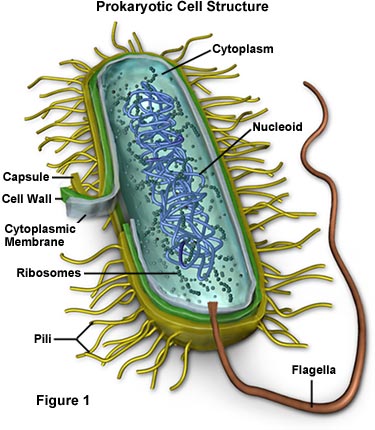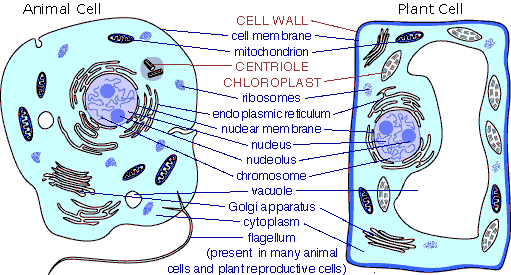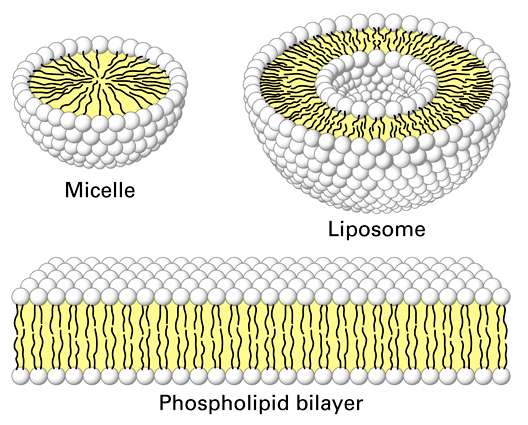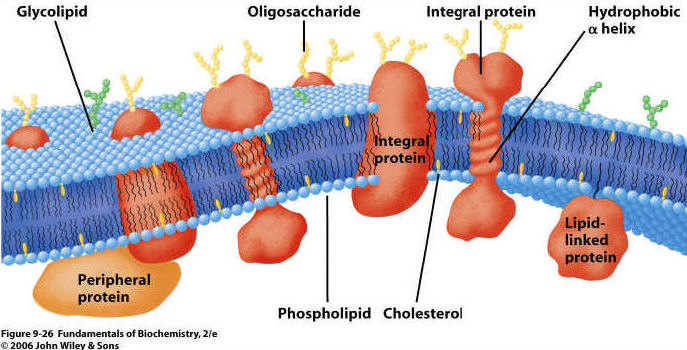 1.
Prokaryotic Cells
1.
Prokaryotic Cells
Cell biology is another great thread of biology. Evolution explains life's diversity, genetics and heredity explain how life reproduces itself, and cell biology explains the fundamental structure of living systems. The birth of cell biology can be traced to the observations of Robert Hooke in 1655, who observed thin sections of cork through a microscope. The box-like compartments reminded him of cells in a monastery, and he coined the term. Of course, he was not observing true living cells - only the cell walls in dead plant tissue. The first observation of live cells was made by Antony van Leeuwenhoek in 1674 who observed protists, algal cells, and bacteria. In 1838-9, Schleiden and Schwann independently proposed that all plants and animals (respectively) were composed of cells - the 'cell theory' of life. They also supported the notion that cells propogated 'spontaneously' like crystals; but this would premise would be rejected by Virchow who, in 1858, famously wrote "omnis cellula e cellula" - 'all cells from cells'. Several cellular structures were observed during this period, as well: Brown described the nucleus in 1833, Kolliker described mitochondria in 1857, and Flemming described the movement of chromosomes and the stages of mitosis in 1879. Robert Koch isolated the bacteria that caused anthrax (1876), TB (1882), and cholera (1883). Pasteur developed vaccines and treatments for killing bacteria and fungi with heat (pasteurization). The contributions of Koch and Pasteur firmly established the 'germ theory' of disease and finally laid the idea of spontaneous generation - even by microbes - to rest. Following Van Beneden's description of the movement of chromosomes during meiosis in 1883, August Weismann proposed that the 'germ cells' of egg and sperm, although produced by 'somatic' body cells, were separated from them and were uninfluenced by them (1893); eliminating the possibility of the inheritance of characteristics acquired by the body. After the 'rediscovery' of Mendel's work in 1900 by Tschermak, DeVries, and Correns, Walter Sutton (1902) unified heredity and cell biology by recognizing the correlation between the movement of chromosomes during meiosis and Mendel's principles of heredity. He proposed that chromosomes carry the hereditary material - the 'chromosomal theory of heredity'.
All living things are composed of cells, so understanding how a cell works is fundamental to understanding all living systems (reductionism, remember?). Before we examine the patterns of heredity and the structure and function of DNA (topics directly relevant to our discussion of evolution), we will quickly review the cellular context in which DNA functions. At the most simplistic level, cells must absorb matter/energy, convert this matter/energy into a useable form, and then use this energy and matter to make the things they need, respond to the environment, and reproduce. To understand the material that follows, you must know the basics of atom structure, types of chemical bonds, the structure and properties of water, and the basic structure of biologically important molecules. This is basic science stuff covered in every high school chemistry and biology class, so it is assume knowledge here. If you want an overview of what you are responsible for, see this link: review of atoms, bonds, and molecules.
- All truly living things are composed of cells - from bacteria to blue whales to sequioas. Viruses, which are not capable of independendent metabolism and reproduction, are not cellular and straddle the definition of 'living'. And surprizingly (in some respects), these cells are all remarkably similar in their basic structure and function. They all have a plasma membrane composed of a lipid bilayer. They all have genetic material composed of DNA, and protein synthesis is performed by ribosomes. In addition, all cells can metabolize glucose and use ATP as the 'energy currency' in the cell.
- Although the largest bacterium so far discovered (Thiomargarita namibiensis) is 0.7mm (millimeters) long, most prokaryotic cells are thousands of time smaller, typically 0.2 - 2.0 um (micrometers)! And most prokaryotic cells are typically 100 times smaller than typical eukaryotic cells (usually 10-100 um). The largest eukaryotic cell, by weight, is an unfertilized ostrich egg. The longest eukaryotic cell may be a neuron in the leg of a giraffe, with the cell body in the spinal cord and the axon running the entire length of the leg.
 1.
Prokaryotic Cells
1.
Prokaryotic Cells
Prokaryotes ('eubacteria' and 'archaea') have cells that lack a nuclear membrane and membrane-bound organelles. Many have a polysaccharide coating (glycocalyx), or a cell wall. They also lack a cytoskeleton, and their flagella are structurally simple. They divide by binary fission - a much simpler process than the more complicated mitotic division that eukaryotes perform. And finally, prokaryotes do not produce specialized haploid gametes for sexual reproduction. However, they can exchange DNA between cells to create new genetic combinations. Although we often think of bacterial cells as independent organisms, most bacteria live in complex aggregates called 'biofilms'. When the cells join a biofilm, their physiology changes and they become a contributing member of a larger complex colony of microbial life nested in a protective layer of the slime they secrete. Examples of biofilms are dental plaque, the slime inside water and sewer pipes, and large colonies of bacterial and algal mats called stromatolites. As we will see later, although bacteria are not that structurally diverse (rods, spheres, and spirals), they are in many ways more metabolically diverse than eukaryotic cells.
2. Eukaryotic Cells
 Eukaryotes
(protists, plants, fungi, and animals) have cells with a nucleus at some stage
in their life cycle (some cells like red blood cells may lose this nuclear membrane).
All eukaryotes except a few unusual protists have mitochondria - internal, cell-like
structures with their own membranes and DNA. The photosynthetic eukaryotes also
have membrane-bound chloroplasts. Their ribosomes are larger than those of prokaryotes,
but they perform the same function of protein assembly. They also have an internal
membrane system of the Endoplasmic Reticulum, Golgi Apparati, and Liposomes.
Chromosomes are circular in some protists, and are linear in other eukaryotes.
Some plants have more than 1000 chromosomes
in the nucleus of each cell. Cells of plants, fungi, and some protists
have protective cell walls composed of cellulose (plants and some protists)
or chitin (fungi and some protists). Plant cells also have a large central vacuole
for water storage and water regulation. Vacuoles and vesicles are compartments
that occur in the cells of other life forms, too - for the storage of nutrients
or waste.
Eukaryotes
(protists, plants, fungi, and animals) have cells with a nucleus at some stage
in their life cycle (some cells like red blood cells may lose this nuclear membrane).
All eukaryotes except a few unusual protists have mitochondria - internal, cell-like
structures with their own membranes and DNA. The photosynthetic eukaryotes also
have membrane-bound chloroplasts. Their ribosomes are larger than those of prokaryotes,
but they perform the same function of protein assembly. They also have an internal
membrane system of the Endoplasmic Reticulum, Golgi Apparati, and Liposomes.
Chromosomes are circular in some protists, and are linear in other eukaryotes.
Some plants have more than 1000 chromosomes
in the nucleus of each cell. Cells of plants, fungi, and some protists
have protective cell walls composed of cellulose (plants and some protists)
or chitin (fungi and some protists). Plant cells also have a large central vacuole
for water storage and water regulation. Vacuoles and vesicles are compartments
that occur in the cells of other life forms, too - for the storage of nutrients
or waste.
Consider a new cell just produced by binary fission or mitotic division of a pre-existing cell. This cell is roughly half the size of the parental cell. To reach the size of the parental cell, it must grow - this involves the synthesis of more membranes, more ribosomes, and more of all the other components of a cell. In addition, some molecules are breaking down naturally and must be replaced or repaired. So, a cell has to make stuff to keep itself alive and grow. The first law of thermodynamics states that: "energy/matter can not created or destroyed, only transformed to other types of matter/energy". So, for a cell to maintain itself and grow, it can't just 'create' this new matter of membranes and ribosomes from nothing; it must take in energy and matter and transform that energy/matter into these necessary structures. Cells harvest energy and create new molecules through chemical reactions - breaking molecules apart and linking their pieces together in new combinations. These chemical reactions are catalyzed by enzymes. The enzymes are molecules made by the cell, too, through other enzymatically catalyzed chemical reactions. Most enzymes are proteins. So, to make the lipids, polysaccharides, proteins, and nucleic acids that a cell needs, it must make the proteinaceous enzymes needed to sythesize these molecules. Protein (enzyme) synthesis is thus fundamental to everything else a cell does.
We can summarize cell function like this (for eukaryotic cells): biological molecules are absorbed across the membrane. Through chemical reactions (catalyzed by enzymes) in the cytoplasm and the mitochondria, the covalent bonds in these organic molecules are broken and some of the energy released by the breaking of these bonds is used to add a phosphate group to ADP--> making ATP. This is cellular respiration - transforming the energy contained in the covalent bonds of diverse organic molecules into the energy in a weak covalent bond of a single type of organic molecule (ATP). All enzymes can break these weak bonds in ATP to catalyze their reactions. Photosynthetic cells can also use the energy in sunlight to link a phosphate group to ADP--> making ATP; converting radiant energy into chemical energy of a covalent bond. In these two ways, cell transform energy in a diverse range of nutrients or light into one form of chemical of energy (bonds in ATP) that can be used throughout the cell. Much of this energy is used to link amino acids together to make proteins. These reactions occur at the ribosomes, which many be free in the cytoplasm or bound to the endoplasmic reticulum (ER), making the ER appear fuzzy or 'rough'. Proteins synthesized by ribosomes on the rough ER are shunted into the lumen (tube) of the ER, where they are passed to the Golgi Apparatus for processing (changing the initial protein product into a functional protein by cutting off some amino acids, and or binding it to another protein, fat, or carbohydrate). Liposomes budding off from the Golgi transfer the final protein product to the cell membrane, for incorporation in the membrane or delivery outside the cell. The sequence of amino acids in each protein is determined by the linear sequence of nitrogenous bases in genes - regions of DNA in chromosomes. The DNA double helix is opened, and the sequence of A,T, C, and G's is read. Based on this sequence, a complementary sequence of RNA is synthesized. This RNA molecule - essentially a copy of the gene - is shunted outside the nucleus to the ribosome. It is this RNA which is "read" by the ribosome, and determines the particular sequence of amino acids linked together into the initial protein product. All of these steps, from uncoiling the DNA, to reading the DNA, to making the RNA, to moving the RNA to the ribosome, the linking amino acids together to form the protein require other specific enzymes and energy in the form of ATP. Throgh this process of protein synthesis, the cell makes the enzymes it needs to synthesize new structural and transport proteins, new phospholipids, new polysaccharides, and new chromsomes. Once new chromosomes are synthesized, the cell can divide into two new cells. That's a very simple look at how cells live. It involves absorbing matter/energy, converting that energy to a usable form, making proteins based on the recipes in the DNA, and then reproducing. We will now look at these steps in more detail.
All living cells are bounded by a membrane composed of a phosopholipid bilayer. Proteins are present on and within each layer, and some also cross all the way through the membrane.
 1.
Phospholipid Bilayer:
1.
Phospholipid Bilayer:
- phospholipids have hydrophobic
fatty acid tails and hydrophilic phosphate group "heads" (charged).
In an aqueous solution, phospholipids will form micelles (single layer spheres)
and bilayers (two layer spheres and films) as a function of the hydrophobic
and hydrophilic nature of these molecules. These spatial orientations surround
the hydrophobic fatty acid 'tails' with the hydrophilic phosphate 'heads' that
interact with the polar water molecules in the solution. When arranged as a
bilayer, they separate the internal aqueous solution of the cell from the external
aqueous environment. Because the principle boundary is the hydrophobic, non-polar
layers of fatty acids, the bilayer is permeable to lipid-soluble materials but
not water soluble (polar and ionic) materials unless they are very small. These
bilayers are also very dynamic or "fluid"... the phospholipids are
moving laterally all the time, like the lipids in a soap bubble.
2. Proteins arepresent on both
inner and outer surfaces, and also extending through the lipid bilayer.
3. Carbohydrates on the surface;
usually attached to proteins and forming a "glycoprotein"

2. Transport: matter does cross the membrane. However, unless it is a small or non-polar molecule, it cannot cross the lipid bilayer "on its own". Rather, crossing the membrane must be assisted by a protein. These proteins may be rather unselective "tubes", or they may be specific for the transport of a particular class of molecules. By using proteins as 'gates' the cell gains control over the composition of its cytoplasm. There are three ways that material can cross a membrane:
a. Diffusion: As a consequence of the random movement of molecules, molecules will disperse from areas of high concentration and move to areas of lower concentration. So, when you uncork a bottle of perfume, the molecules diffuse through the room from high concnetration at the bottle to low concentration in the rest of the room. Molecules may cross membranes as they move in this manner, moving from areas of high concentration on one side of the membrane to areas of lower concentration on the other. With respect to the lipid bilayer in living membranes, non-polar molecules and some small molecules can diffuse directly through the lipid bilayer. The movement of CO2 and O2 across the membrane happens by diffusion. Every molecule moves by diffusion in response to its own concentration gradient.
The movement of water across a membrane, in response to its water potential, is called osmosis (video). Although water is polar, it is also a small molecule. So, it can cross the lipid bilayer directly, or through specialized protein channels called 'aquaporins'. Water potential is a bit more complicated than just 'concentration', although it includes this idea. The higher the concentration of dissolved solutes, the lower the 'concentration' of water and the lower the water potential. These solutes may be one or many things, so water potential is a function of total solute concentration. So, water will osmose across a membrane from an area of low solute concentration (high water potential) to an area of high solute concentration (low water potential), or in other words, from a dilute solution to a concentrated solution. Another component of water potential is water pressure: water will also cross a membrane due to pressure exerted by an outside force or the force of its own mass responding to gravity. So water can be pushed across a membrane.
Consider the figure, below. The purple circles are dissolved solutes. SO! In the first figure at left, total solute concentration is HIGH on the right side of the u-tube, so water potential is LOW . Water will move across the membrane from the dilute solution on the left (high water potential) to the concentrated solution on the right (low water potential), and the water level will rise (figure on the right). Eventually, in this rigid vertical system, the tendancy of the water to move left to right in response to solute concentration is balanced by the tendancy of water to move right to left - "leaking" back across the membrane - in response to the greater water pressure. An equilibrium is reached where there is no NET flow. In a rigid plant cell (with a cell wall), the influx of water creates "hydrostatic pressure" and makes the cell rigid or 'turgid'. The loss of water (from evapotranspiration or osmosis out of the cells to a saltier environment) reduces this turgidity - or 'turgor pressure' - and the plant tissue wilts (gets 'floppy'). In an animal cell bounded only by a thin membrane, the influx of water can create a pressure large enough to rupture the cell. We will deal with these concepts more in lab.
b. Faciliated Diffusion: Large polar molecules cannot diffuse across the lipid bilayer. However, they can cross the membrane 'passively' from high to low concentration, through integrated proteins channels. Some of these channels are rather unspecialized 'tubes', while other channels are rather specific and will only permit the transport of certain classes of molecules. In any case, this is the way that large polar molecules cross the membrane in response to their concentration gradient (high to low). video.
c. Active Transport: If material only crossed the membrane by some form of diffusion, then the cell's cytoplasm would come to be very similar to the surrounding environment. They cell would be unable to raise or lower the concentration of material above the concentration in the environment. In order for cells to be differnt from the environment (in the concetration of some stuff), another mechanism is needed. This is 'active transport'. In active transport, a cell uses energy to 'pump' material across the membrane - against the concentration gradient (from low to high). So, although sugars might be in higher concetration within the cell than outside it, and although sugars may be "leaking" from the cell by diffusion, the cell can pump sugar against the concentration gradient and accumulate it in the cell. Likewise, a cell can pump toxins or waste OUT of the cell, even if the concentration outside of the cell is already high. THIS TAKES ENERGY - LIKE ROLLING A BALL UPHILL, AGAINST THE 'GRADIENT' OR SLOPE. An important active transport mechanism is the "sodium-potassium" pump. In this process, both ions are pumped against their concentration gradient, using energy (breaking ATP) to change the conformation of the transport protein. video
3. Metabolism: Some of the proteins associated with the membrane are enzymes that catalyze reactions. By positioning enzymes next to one another that catalyze sequential reactions in a process, the process can run much more efficiently.
4. Signal transduction: Proteins can also be involved with 'perception'. When a membrane protein binds a compound in the environment, it may change shape. This shape change may release a subunit inside the cell that binds to something else and initiates a cellular response. So the cell perceives a stimulus in the environment and responds - all at the chemical level. The percetion of a signal can stimulate the activation or inactivation of a gene - and thus affect the proteins that a cell produces and the cell's basic physiology. video
5. Cell-cell recognition: Surface proteins and carbohydrates give a cell a chemical 'signature'. This is critical in the immune system, where cells are identified as "self" or "foreign" based on these surface antigens.
6. Cell binding: In many tissues (but not all, such as blood), the cells are bound together; sometimes quite tightly. This cell-cell binding usually involves proteins that interlock and bind together.
7. Attachment of the cytoskeleton: a cell is not a "baggie" with organelles floating around in the cytoplasm. Most organelles (like mitochondria and chromosomes) are bound to cytoskeletal fibers that hold them in position. The cytoskeleton is also responsible for changin the cells' shape.
Study Questions:
1. List three differences between prokaryotic and eukaryotic cells.
2. What is a biofilm?
3. Describe the function of mitochondria, ribosomes, endoplasmic reticulum, Golgi apparatus, and vesicles that bud from the Golgi.
4. Why is the lipid bilayer a barrier to water soluble molecules?
5. Describe diffusion, facilitated diffusion, and active transport.
6. How does solute concentration and pressure affect water potential and osmosis?